It was difficult to make a list of all endangered ocean animals from more than a million species. However, we have managed to create a top 10 list based on the IUCN report. So, in no particular order, here are the details of these creatures.
10 Endangered Ocean Animals
Here are the details of 10 endangered ocean animals. Read on.
Green Sea Turtles
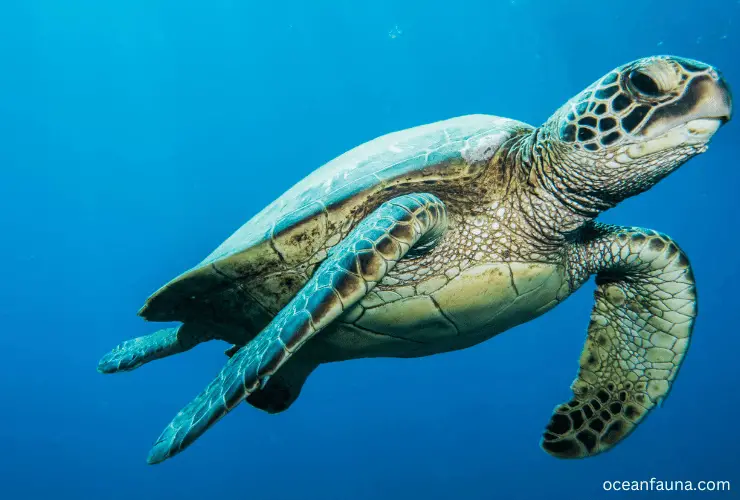
Conservation Status: Chelonia Mydas, also known as Green Turtle, was last evaluated for its conservation status in 2004 by The IUCN Red List of Threatened Species. It has been categorized as Endangered based on criteria A2bd.
The Green Sea Turtle is a large marine reptile that is found in tropical and subtropical waters around the world. They face a number of threats, including habitat loss, pollution, and accidental capture in fishing gear. Additionally, their eggs and meat are considered a delicacy in many parts of the world.
The Green Sea Turtle conservation efforts have concentrated on safeguarding their nesting beaches and decreasing accidental catches of the turtles in fishing gear. Moreover, numerous programs are established in various regions to enlighten people regarding the significance of these creatures and the hazards they are exposed to.
Blue Whale
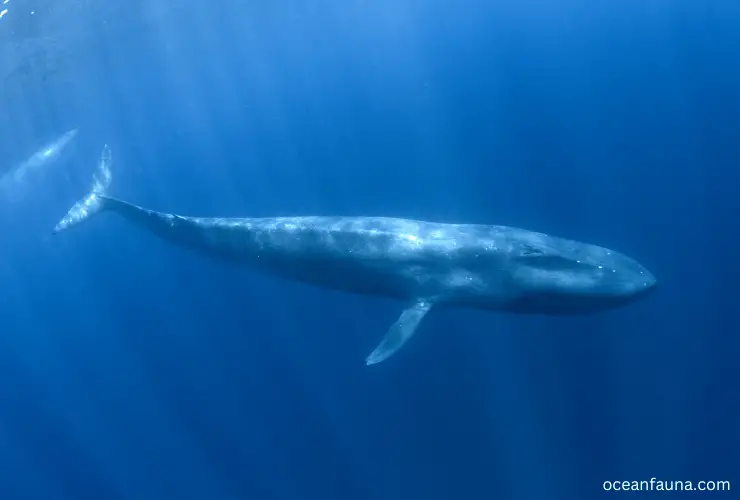
Conservation Status: The Blue Whale, also known as Balaenoptera musculus, was last assessed for The IUCN Red List of Threatened Species in 2007 and is listed as Endangered under criteria D.
But, the Antarctic Blue Whale is a subspecies of Balaenoptera musculus and is known as Balaenoptera musculus ssp. intermedia was last assessed in 2018 for The IUCN Red List of Threatened Species and is listed as Critically Endangered under criteria A1abd.
The Blue Whale is the largest animal in the world and can be found in all of the world’s oceans. They were once heavily hunted for their oil and meat, which led to a significant decline in their population. Today, their population is estimated to be only a fraction of what it once was.
On the other hand, the Antarctic Blue Whale is found in the Southern Ocean. It is considered to be endangered due to its small population size and the ongoing threats of climate change, pollution, and commercial whaling.
Conservation efforts aimed at preserving the Blue Whale and the Antarctic Blue Whale have put emphasis on putting an end to commercial hunting and minimizing the impact of human activities on their habitats.
Hawaiian Monk Seal
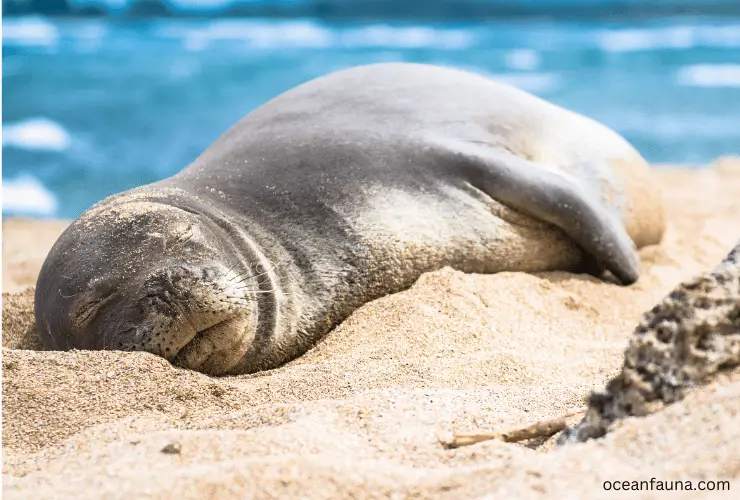
Conservation Status: The 2014 assessment for The IUCN Red List of Threatened Species has determined that the Hawaiian Monk Seal, also known as Neomonachus schauinslandi, meets the criteria to be classified as Endangered under C1.
The Hawaiian Monk Seal is found only in the Hawaiian Islands. They face several threats, including habitat loss, fishing gear entanglement, and shark predation.
Conservation efforts for the Hawaiian Monk Seal have focused on protecting their breeding and resting areas, reducing the impact of human activities impact on their habitats, and minimizing the number of seals accidentally caught in fishing gear.
Whale Shark
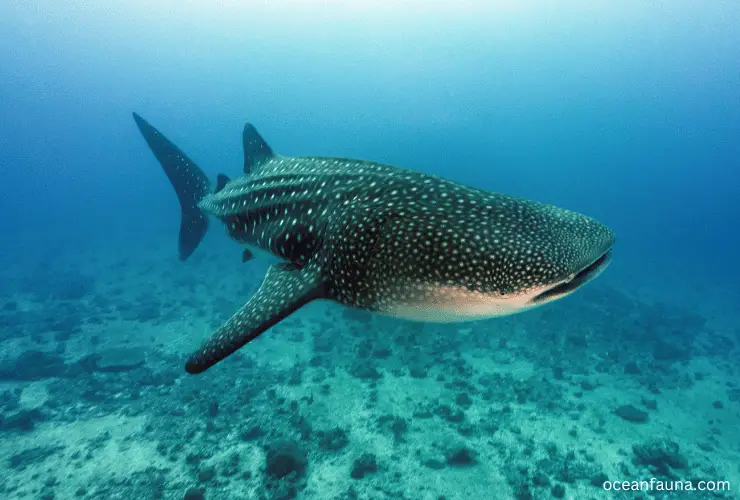
Conservation Status: The IUCN Red List of Threatened Species last assessed the conservation status of the Whale Shark (Rhincodon typus) in 2016. The assessment resulted in the classification of whale sharks as Endangered under criteria A2bd+4bd.
The Whale Shark is the largest fish in the world and is found in all of the world’s oceans. They are considered to be endangered due to their slow reproductive rate and the ongoing threats of overfishing, bycatch, and habitat loss.
To protect Whale Sharks, we have been focusing on preserving their habitats, limiting accidental catches in fishing gear, and reducing the impact of human activities on their numbers.
Western Steller Sea Lion
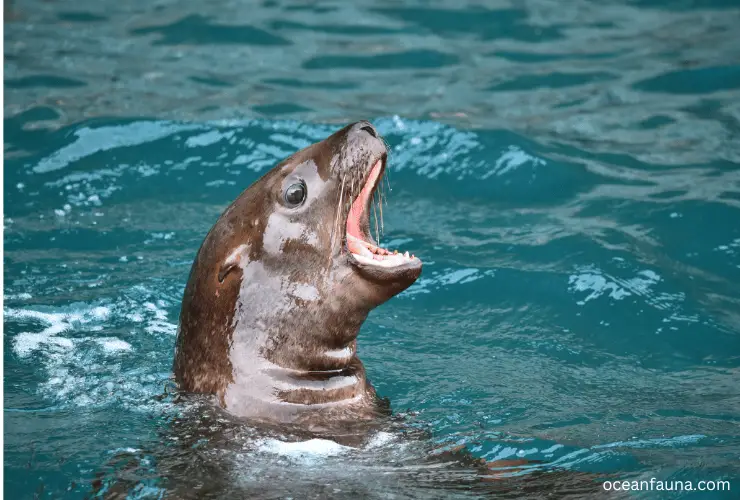
Conservation Status: According to the 2015 assessment by The IUCN Red List of Threatened Species, the Western Steller Sea Lion (Eumetopias jubatus ssp. jubatus) is classified as Endangered under criteria A2a.
The Western Steller Sea Lion is a large marine mammal that is found in the North Pacific Ocean. They face a number of threats, including habitat loss, overfishing of their prey, and disease outbreaks.
Efforts to conserve the Western Steller Sea Lion have centred on safeguarding their living spaces, decreasing the unintentional capture of sea lions in fishing equipment, and minimizing the influence of human actions on their numbers.
Sea Otter
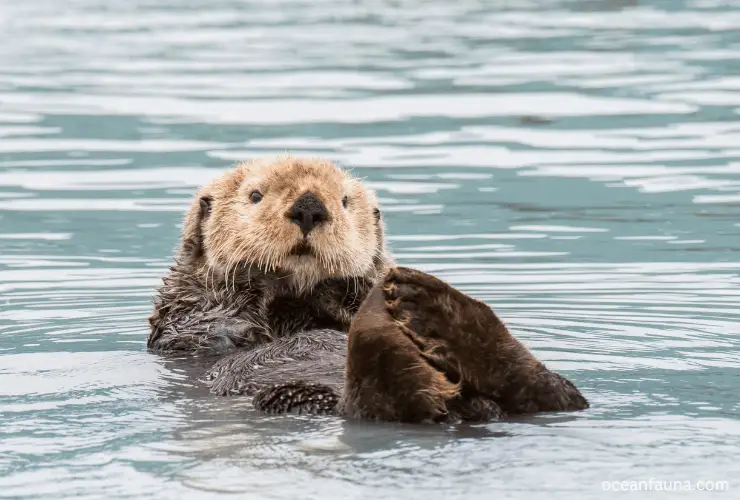
Conservation Status: The assessment of the conservation status of the Sea Otter (Enhydra lutris) was conducted in 2020 by The IUCN Red List of Threatened Species. According to the assessment, Sea Otter is classified as Endangered based on the A2abe criteria.
The Sea Otter is a marine mammal that is found along the coastlines of the North Pacific Ocean. They were once heavily hunted for their fur, which led to a significant decline in their population. Today, they face a number of threats, including habitat loss, overfishing of their prey, and oil spills.
Efforts to conserve Sea Otters are aimed at safeguarding their habitats, preventing accidental trapping in fishing gear, and minimizing the impact of human activities on their populations.
Hector’s Dolphin
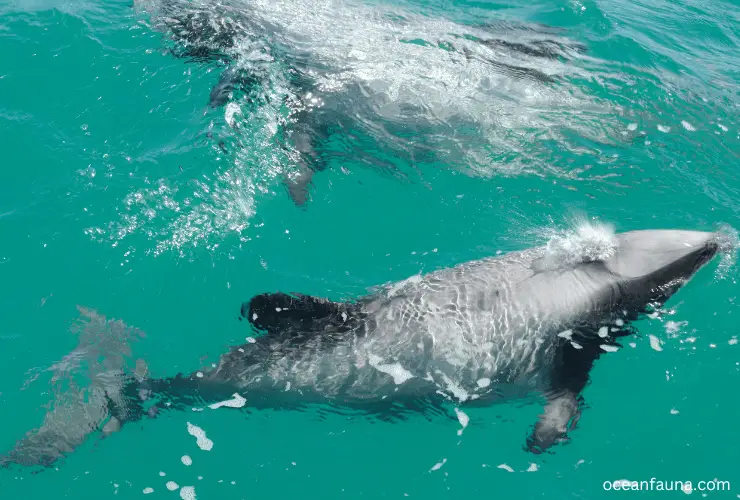
Conservation Status: According to the assessment on The IUCN Red List of Threatened Species in 2008, the Hector’s Dolphin (Cephalorhynchus hector) is classified as Endangered under criteria A4d.
Hector’s Dolphin is the smallest marine dolphin in the world and is found only in the coastal waters of New Zealand. They face a number of threats, including habitat loss, entanglement in fishing gear, and pollution.
Conservation activities for Hector’s Dolphin have focused on protecting their habitats, reducing the number of dolphins that are accidentally caught in fishing gear, and working to minimize the impact of human activities on their populations.
Atlantic Bluefin Tuna
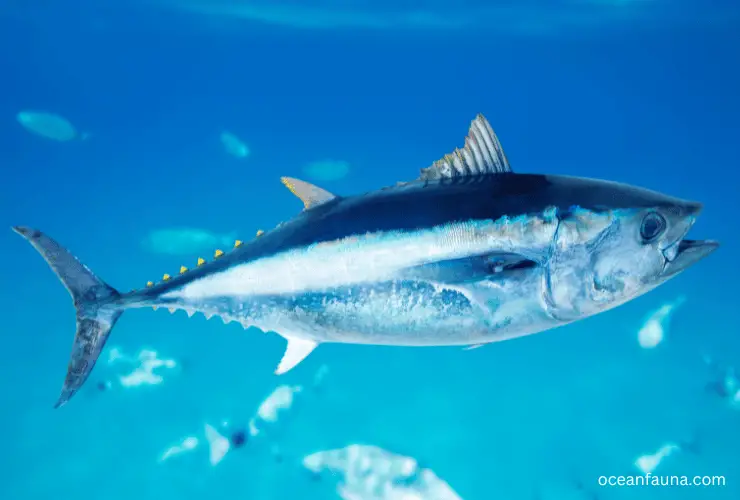
Conservation Status: The 2015 assessment of Atlantic Bluefin Tuna (Thunnus thynnus) for The IUCN Red List of Threatened Species lists it as Endangered under criteria A2bd.
The Atlantic Bluefin Tuna is a big fish found in the Atlantic Ocean. They are endangered because they reproduce slowly and face ongoing dangers such as overfishing, bycatch, and loss of habitat.
To protect Atlantic Bluefin Tuna, people are working to decrease the yearly catch, establish fishing limits, and lessen harm from human actions that affect their numbers.
Fin Whale
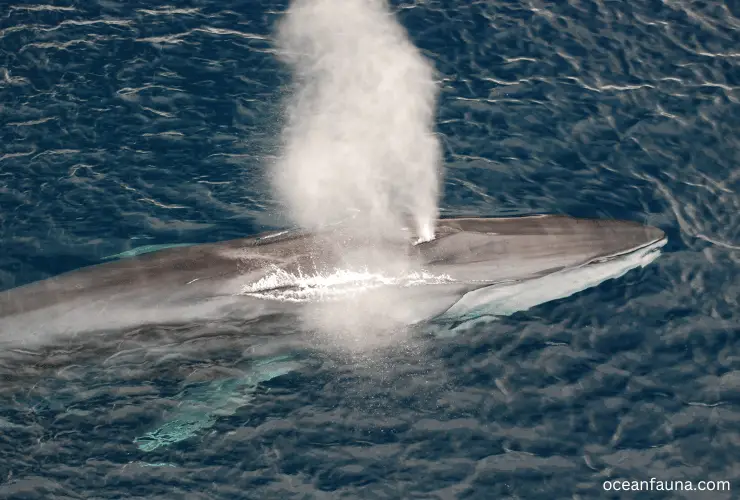
Conservation Status: The 2021 assessment for the IUCN Red List of Threatened Species evaluates the status of the Mediterranean subpopulation of the Fin Whale, scientifically known as Balaenoptera physalus. This subpopulation has been classified as Endangered according to criteria C2a(ii).
The Fin Whale is a large baleen whale that is found in oceans worldwide. They are endangered due to their slow reproductive rate and the continuous threats of overfishing, bycatch, and climate change.
Regarding the protection of Fin whales, we need to identify and safeguard their crucial habitats, reduce unintentional catches in fishing gear, and lessen the negative effects of human activities on their populations.
Humphead Wrasse
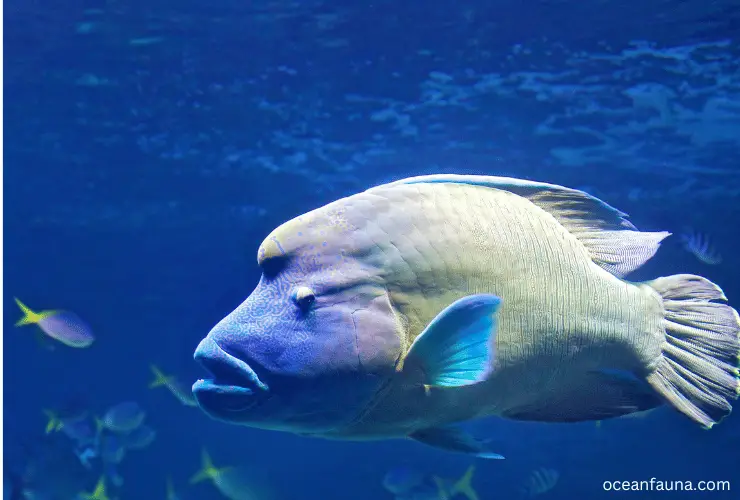
Conservation Status: The Humphead Wrasse, also known as Cheilinus undulatus, was last evaluated for The IUCN Red List of Threatened Species in 2004 and was listed as Endangered based on criteria A2bd+3bd.
The Humphead Wrasse is a large fish that inhabits coral reefs in the Indian and Pacific Oceans. They are endangered due to overfishing, habitat loss, and unsustainable fishing practices.
The activities to conserve Humphead Wrasse have concentrated on finding and safeguarding their habitats, decreasing the unintentional capture of young wrasses in fishing equipment, and lessening the harm caused by human actions to their numbers.
Reasons why an ocean creature is considered “Endangered.”
There are several reasons why an ocean creature might be considered “Endangered”. 6 common reasons are discussed below.
Overfishing
Overfishing is a major threat to many ocean creatures. It occurs when fishing activities exceed the capacity of fish populations to reproduce and replenish themselves. This can lead to a decline in population numbers, which in turn can make a species vulnerable to extinction. Some species, such as sharks, are particularly vulnerable to overfishing due to their slow reproductive rates.
Habitat Destruction
Habitat destruction is another major threat to ocean creatures. This can occur through various activities, including oil spills, pollution, bottom trawling, and dredging. These activities can damage or destroy entire ecosystems, leaving many ocean creatures without a place to live or food to eat.
Pollution
Pollution from industrial and agricultural activities can contaminate the water in which ocean creatures live. This can lead to changes in the water’s chemistry, making it toxic to some species.
Plastic pollution is one of the main threats to ocean biodiversity. Many pollutants also contain chemicals that disrupt hormones or damage organs, decreasing population numbers.
Climate Change
Climate change is also a major threat to ocean creatures. Temperature, ocean chemistry, and sea level changes can seriously impact marine ecosystems. For example, warming oceans can cause coral bleaching, killing off entire coral reefs and the creatures that depend on them.
Ocean acidification can also have serious impacts on ocean creatures, making it harder for creatures like shellfish to build their shells.
Bycatch
Bycatch is another threat to ocean creatures. Bycatch occurs when fishing activities unintentionally capture non-target species, such as sea turtles, dolphins, and birds. This can lead to many unnecessary deaths of these creatures and further endanger their populations.
Illegal Trade
Illegal trade is also a major threat to ocean creatures. Many species, such as sea turtles, are illegally traded for their eggs, meat, and shells. This can have serious impacts on their populations, as well as on the ocean ecosystems in which they live.
Which conservation efforts should be taken to protect endangered ocean animals?
The ocean is crucial in maintaining biodiversity on our planet, and it is home to millions of marine species. However, many of these species are becoming endangered alarmingly due to human activities and pollution.
To protect endangered ocean animals, several conservation efforts should be taken. Here these efforts are discussed below.
Establish Marine Protected Areas (MPAs)
Marine Protected Areas are regions where human activities are restricted or prohibited to conserve marine resources. These areas are designed to protect endangered species from overfishing, pollution, habitat destruction, and other threats. MPAs are being established worldwide, and they are proving to be an effective tool for conserving endangered ocean animals.
Implement Sustainable Fishing Practices
Sustainable fishing practices involve the use of techniques that do not harm ocean ecosystems or endanger marine species. Such practices can include the use of selective fishing gear, closed fishing seasons, and restrictions on fishing locations.
Endangered species can recover by implementing sustainable fishing practices, and fisheries can remain viable in the long term.
Reduce Pollution
Pollution is a serious threat to ocean animals, and it can cause significant harm to their habitats and food sources. Reducing pollution not only protects ocean animals but also helps to maintain healthy ecosystems.
To reduce pollution, we need to reduce our use of single-use plastics and microplastics, properly dispose of hazardous waste, and regulate industrial waste disposal.
Protect Critical Habitat
Critical habitat areas are regions endangered species rely on for survival, such as breeding or feeding grounds. Protecting these areas can help ensure that endangered species have access to the resources they need to thrive. Examples of critical habitat areas include coral reefs, seagrass beds, and feeding grounds for whales and dolphins.
Collaborate with Local Communities:
Collaboration with local communities is essential for the success of conservation efforts. Local communities can provide valuable insights into the needs and challenges of the ocean ecosystem. Collaborative efforts can include education programs, eco-tourism, and sustainable economic activities. By working together, we can protect endangered species and promote sustainable use of ocean resources.
What are the differences between “Endangered” and “Critically Endangered” species?
The terms “Endangered” and “Critically endangered” are used to classify species based on the severity of their population decline and their knowledge of the cause. While both statuses indicate that a species is at risk of extinction, there are some key differences between them.
A species is considered “Endangered” when its population has declined by at least 80 per cent, and the cause of this decline is not fully understood.
In other words, there is evidence of a significant reduction in the number of individuals of the species, but the reason for this decrease is not clear. This can make it challenging to develop conservation measures that can effectively protect the species and help its population recover.
On the other hand, a species is classified as “Critically Endangered” when its population has declined by at least 90 per cent, and the cause of this decline is known.
In this case, there is a clear understanding of what is causing the population to decline, and this knowledge can help researchers and conservationists to develop targeted interventions to address the underlying problem.
For example, if the decline is due to habitat loss, conservation efforts can focus on protecting remaining habitats or restoring areas that have been destroyed.
Overall, the primary difference between endangered and critically endangered species is the level of knowledge regarding the reasons behind population decline.
Conclusion
Hopefully, you have an overall idea of all the 10 endangered ocean animals discussed in this blog. Proper conservation efforts are necessary to protect all these sea creatures.
Government, NGOs, and all individual efforts are of utmost importance for protecting and conserving ocean wildlife. Marine protected areas, sustainable fishing practices, reducing pollution, and protecting critical habitats are some of the important ways to protect endangered ocean animals.

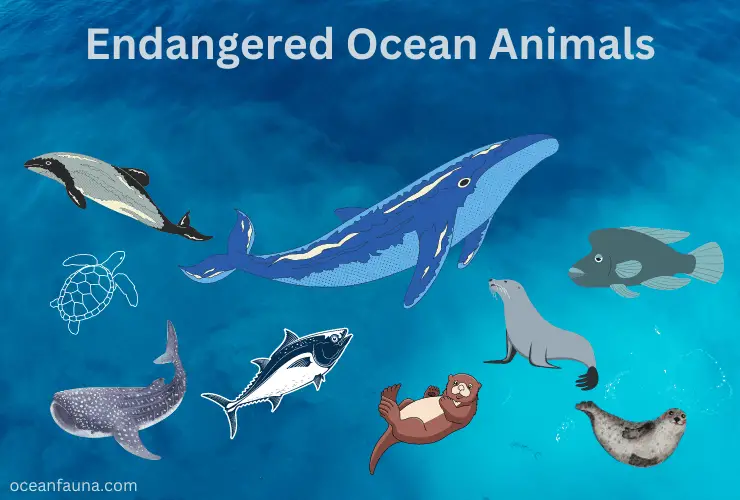
1 thought on “10 Endangered Ocean Animals with Photos”